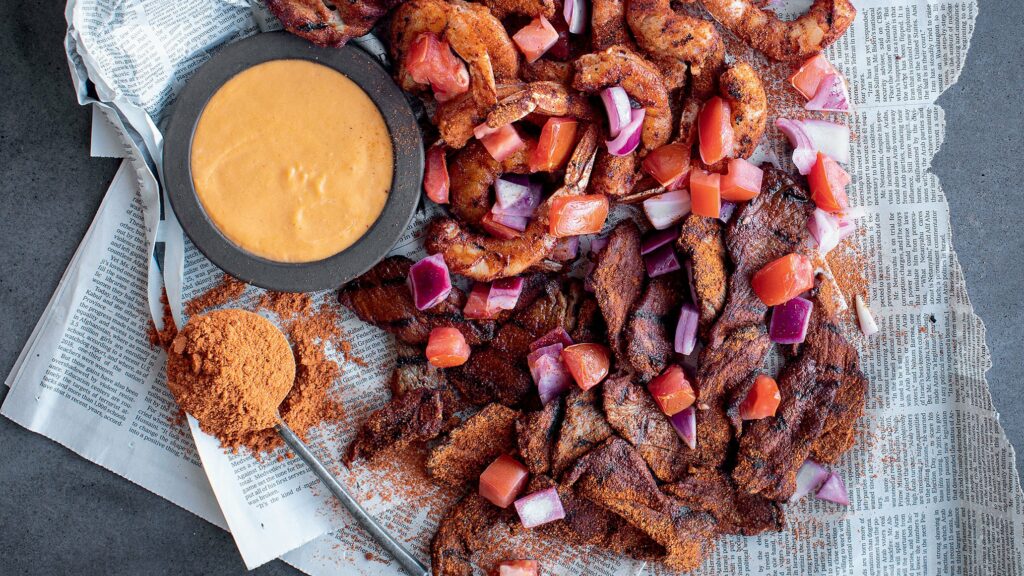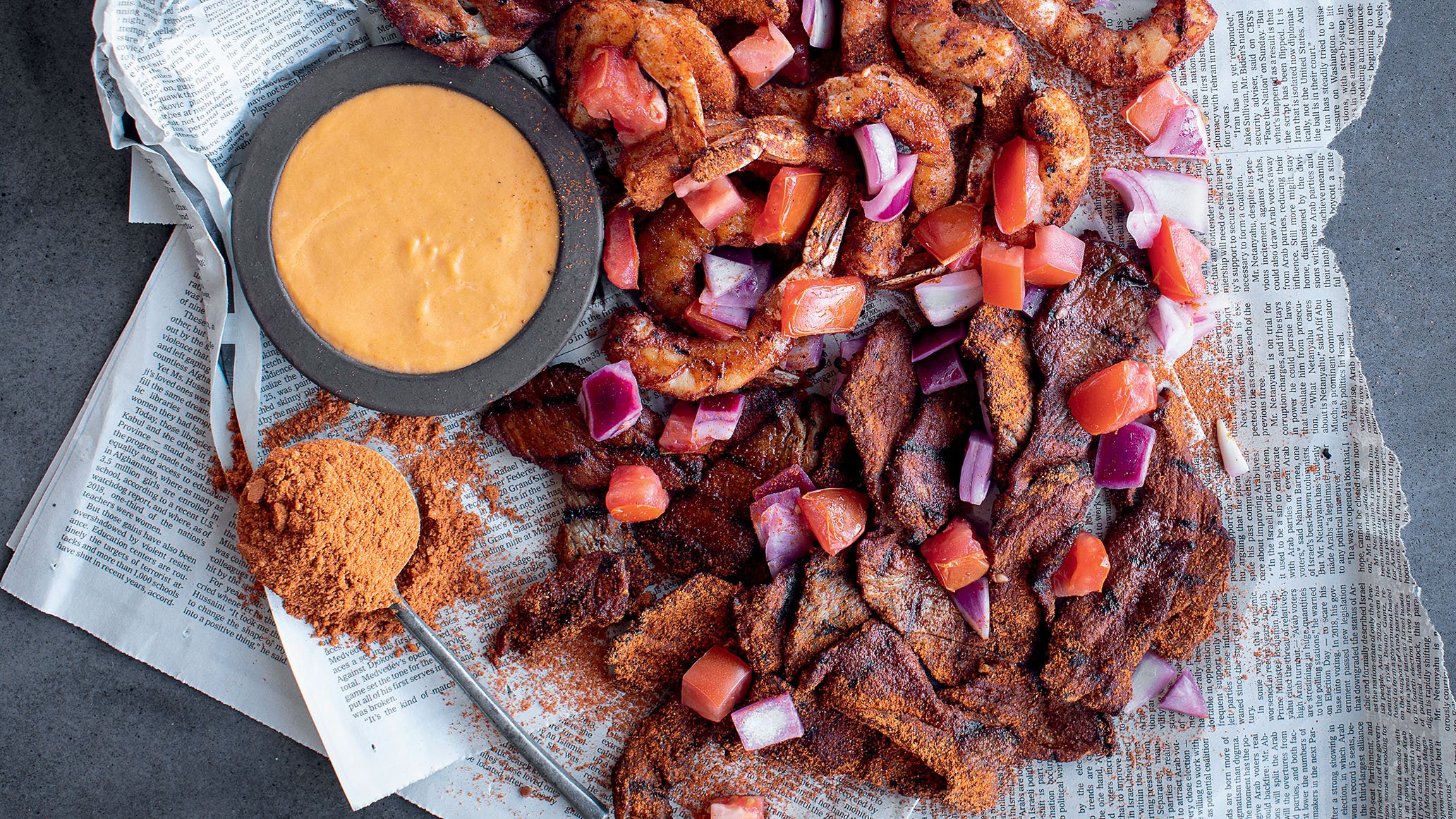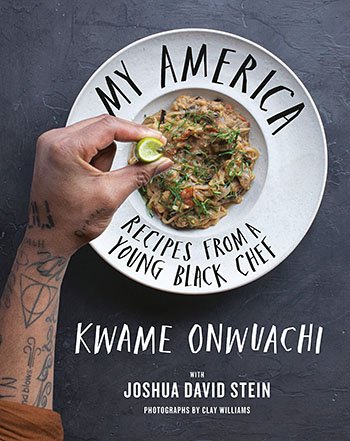 Suya is the grandfather of American BBQ. In Nigeria, the spices draw out and fire up the meats, often cooked over an open flame. Here I do the same. But if you don’t have a grill, use a well- oiled cast- iron skillet over high heat in a kitchen with open windows. The open windows are very important, unless you find the blare of a smoke alarm harmonious and enjoy fits of sneezing. I find the sweetness of the char plus the heat of the spice totally irresistible. I did when I first smelled it from beyond the walls of my grandfather’s compound in Nigeria, or when we went to market when I could sneak a skewer. (Since my grandfather was an obi, or chief, there were many customs and rules around what he and his family could eat.) When I opened my second restaurant, Kith and Kin, I wanted to suya everything. The reaction from the diners, at least initially, was mixed. Many Nigerians scoffed at the idea that suya could be applied to, for instance, brussels sprouts. They were, on the whole, proud that Nigerian cuisine was being given the attention it so much deserved but arrived at the table with some strong opinions. Judging from the empty bowls that came back to the kitchen, I think I won them over. But it was always a battle.
Suya is the grandfather of American BBQ. In Nigeria, the spices draw out and fire up the meats, often cooked over an open flame. Here I do the same. But if you don’t have a grill, use a well- oiled cast- iron skillet over high heat in a kitchen with open windows. The open windows are very important, unless you find the blare of a smoke alarm harmonious and enjoy fits of sneezing. I find the sweetness of the char plus the heat of the spice totally irresistible. I did when I first smelled it from beyond the walls of my grandfather’s compound in Nigeria, or when we went to market when I could sneak a skewer. (Since my grandfather was an obi, or chief, there were many customs and rules around what he and his family could eat.) When I opened my second restaurant, Kith and Kin, I wanted to suya everything. The reaction from the diners, at least initially, was mixed. Many Nigerians scoffed at the idea that suya could be applied to, for instance, brussels sprouts. They were, on the whole, proud that Nigerian cuisine was being given the attention it so much deserved but arrived at the table with some strong opinions. Judging from the empty bowls that came back to the kitchen, I think I won them over. But it was always a battle.
For this recipe, you’ll need to make three sub-recipes:
Suya Spice
Origin: Nigeria, Yield: 1 pint
The first time I came across suya sellers was when I was sent to live with my grandfather, an obi, or chief, in Nigeria. From over the walls of his compound drifted intoxicating smells of spice-touched smoked meat called suya, meat I later learned was marinated in suya spice, also called yaji spice. But due to tradition, which stated that no one from the house of an obi could eat outside the home, my grandfather forbade us from eating from these mai suya, as the vendors are called. It wasn’t until later that I came to fully appreciate the magic this spice mixture, developed by the northern Hausa tribe of Nigeria, works on meat. It is the grandfather of American barbecue. Built around the native ingredients of West Africa—chili pepper, onion, and ground nuts—and layered with the char of an open flame, Nigerian suya is often made with beef or goat. But it turns everything, from duck and chicken to shrimp and even brussels sprouts, into a deeply flavorful, almost irresistible meal.
2 tablespoons + 1½ teaspoons grains of paradise (or alligator pepper)
5 Maggi Seasoning cubes (vegetable flavor)
6 tablespoons + 1½ teaspoons cayenne
½ cup peanut butter powder
2 tablespoons + 1½ teaspoons sweet paprika
2 tablespoons + 1½ teaspoons onion powder
2 tablespoons + 1½ teaspoons garlic powder
2 tablespoons ground ginger
Blitz the grains of paradise in a high-powered blender or spice grinder until finely powdered, then set aside in a medium bowl. Blitz Maggi cubes until finely ground, then add to the bowl with the grains of paradise. Add all the other ingredients to the bowl and whisk well to combine.
Ginger-Garlic Purée (GGP)
Origin: India, Yield: 1 pint
Together with Peppa Pauce, GGP—ginger-garlic puree—is a key ingredient in the majority of dishes that come out of my kitchen. The combination of the wake-up-your-mouth zing of ginger and the slightly softer garlic is common throughout the Caribbean, but I owe this particular preparation to my friend Alex Sanchez. Alex and I worked together at Eleven Madison Park. At the time, I thought he was just some bright, friendly kid from San Francisco. But at one point, we had a culinary student from India come in, who told me, eyes wide, “I just never thought I’d be working next to Alex Sanchez. The Alex Sanchez.” I looked over at Alex, and he looked a little embarrassed. Turns out he was, even then, a celebrity chef in India, where he ran the Table, one of the country’s best fine-dining restaurants. He had never mentioned that to me. Over the years, I’ve visited him a few times in Mumbai to do pop-ups. On one visit, I wanted to make a curry, and his cooks reached for the GGP. They told me it’s in everything they make, and, once I started using it as a base flavor, I understood why.
2 large stems ginger, peeled and thinly sliced
1 ½ cups garlic cloves
¾ cup grapeseed oil
Combine all the ingredients in a high-powered blender or food processor and process until smooth.
Spice Pickling Liquid
Origin: American South, Yield: 3 cups
Pickling is an act of food preservation and also, thankfully for us, adds an entire dimension of bright angular flavors. This pickling liquid includes a touch of spice but it largely neutral, allowing the flavors of the pickled vegetables to emerge. I like the balance between the thyme and coriander on the softer herbal side with the habanero and ginger more biting, but play around as you like. Garlic goes well, ditto allspice, cloves, and bay leaf. Here’s your chance to go freeform and experiment with what aromatics you use in the pickling liquid and what you pickle. Among my favorite vegetables to pickle are onions, mushrooms, and pig’s feet—which aren’t a vegetable at all, of course, but are delicious.
1 ¾ cups white wine vinegar
¼ cup granulated white sugar
3 tablespoons + 1 teaspoon kosher salt
12 fresh thyme sprigs
4 teaspoons whole coriander seeds
½ habanero pepper, stemmed, seeded, and roughly chopped
2 thin slices ginger, about 2-3 inches long
2 cups water
Place all the ingredients into a medium pot and bring to a boil over high heat. As soon as it comes to a boil, remove it from the heat. Let cool completely, then strain through a fine-mesh sieve and transfer to a clean jar with a tight-fitting lid.

Suya
Ingredients
For the Suya and to assemble
- 1 pound large (16– 20 size) shrimp, peeled and deveined
- 1 pound boneless ribeye steak, excess fat trimmed, sliced into ¼- inch strips
- 1 pound boneless, skinless chicken thighs, sliced into¼- inch strips
- 4 1/2 tablespoons Suya Spice (above), divided, plus more to garnish
- 1 1/2 teaspoons kosher salt, divided
- 1/4 cup roughly chopped fresh parsley
- Tomato-ginger soubise, to serve
- Pickled tomatoes and onions, to serve
- Lime wedges, to serve
For the Tomato-Ginger Soubise
- 1 Roma tomato, roughly chopped
- 2 teaspoons extra-virgin olive oil
- Kosher salt, to taste
- 2 tablespoons grapeseed oil
- 3 tablespoons Ginger-Garlic Purée (GGP) (above)
- 1 yellow onion, thinly sliced
- 1 cup heavy cream
- 1 cup whole milk
For the pickled tomatoes and onions
- 1 cup Spice Pickling Liquid (above)
- 1 medium red onion, large dice
- 1 medium ripe tomato, large dice
Instructions
- For the suya: Place the shrimp, steak, and chicken in three separate bowls. Season each with 11/2 tablespoons of suya spice and 1/2 teaspoon salt, mixing well to combine. Cover with plastic wrap and refrigerate for at least 1hour. (You can marinate the shrimp for up to 12 hours, and the steak and chicken for up to 48 hours.)
- For the tomato-ginger soubise: Heat the oven to 400°F. Line a sheet pan with parchment paper. Toss the tomatoes with olive oil and season with salt. Spread evenly over the sheet pan and bake for 15 minutes, until deep red and a little wrinkly.
- Meanwhile, heat the grapeseed oil in a medium pot over medium heat. When it shimmers, add the GGP and cook until fragrant, 2 to 3 minutes. Add the onions and cook until translucent and soft, 7 to 10 minutes. Add the roasted tomatoes, along with the cream and milk. Bring to a simmer and cook, stirring often, until reduced to about 1 cup— watch carefully, as cream has a tendency to boil over, so reduce the heat as necessary to keep it from sputtering or burning— about 1 hour. Remove from the heat and let cool slightly, then transfer to a blender and purée until velvety smooth. Season to taste with salt and set aside. You should have 1 cup of soubise.
- For the pickled tomatoes and onions : Bring the spice pickling liquid to a boil in a small pot. Place the onions and tomatoes in a nonreactive bowl and pour the hot liquid over them, stirring to combine well. Let cool to room temperature, about 1 hour before serving. You should have about 3 cups of pickled tomatoes and onions.
- To assemble: When ready to cook, prepare a grill for high heat. Let it heat for 10 minutes. Grill the shrimp, steak, and chicken, turning occasionally, until deeply browned and cooked through, about 3 minutes for shrimp and steak and 4 to 5 minutes for the chicken.
- In a small pot, warm the soubise over low heat. Place the grilled items on a platter, dust with extra suya spice, and sprinkle with parsley. Serve with warm soubise, pickled tomatoes and onions, lime wedges for squeezing, and jollof rice.
Notes
 From My America: Recipes from a Young Black Chef by Kwame Onwuachi with Joshua David Stein. Copyright © 2022 by Kwame Onwuachi. Excerpted by permission of Alfred A. Knopf, a division of Penguin Random House LLC. All rights reserved. No part of this excerpt may be reproduced or reprinted without permission in writing from the publisher.
From My America: Recipes from a Young Black Chef by Kwame Onwuachi with Joshua David Stein. Copyright © 2022 by Kwame Onwuachi. Excerpted by permission of Alfred A. Knopf, a division of Penguin Random House LLC. All rights reserved. No part of this excerpt may be reproduced or reprinted without permission in writing from the publisher.

